Through storm-chasing trips in the Great Plains, NASA-sponsored research projects, winter-storm weather balloon launches and national forecasting competitions, students in UNC Asheville’s chapter of the American Meteorological Society use real-world experience, integrated with social media and technology, to feed their love for all things weather-related. Their hands-on experiences also help launch their futures.
But first there are weather balloons to release in the dark of night, mountaintop weather stations to maintain, snowfall to tweet about and, somewhere, a tornado or hurricane to track.
While waiting for the call to pack his bags for a weather adventure, UNCA sophomore Kyle Noel says he stays busy forecasting the weather, which is one of his favorite aspects of meteorology. The highlight of forecasting is making an accurate prediction 48 hours or more in advance he says. “I love it when I get it right. That’s the joy of meteorology.”
Noel is one of many chapter members who volunteer to post weekly forecasts for Asheville on the AMS-UNCA website and compete in the University of Oklahoma’s yearlong Weather Challenge.
“During the year, we do two one-week forecasts for 10 different cities,” he says. “We have a couple of really good forecasters here. [Chapter president] Massey [Bartolini] and I are in the top 100 out of 2,000 people right now.”
The national competition is open to all alumni; undergraduate, graduate and Ph.D. students; and faculty and staff. It includes individual and team divisions, with cities selected by a voting process. Competitors’ forecasts must detail the minimum and maximum temperatures, precipitation and maximum wind speeds.
“Last year, Massey was No. 2 out of about 500 forecasters in the freshman/sophomore group,” Noel says. “Right now, I’m third in the freshman/sophomore group this year.”
Noel and Bartolini have a friendly rivalry because they are both close to breaking the record for the best score ever achieved by a UNCA student, says Noel. Last year, UNCA placed seventh out of 60 schools and consistently places in the top 15, Noel says.
Atmospheric connections
Kelly Dobeck says UNCA ranks highly in more than the Weather Challenge. Interested in studying weather since she was a child, she left Strongsville, Ohio, to come to North Carolina because of UNCA’s atmospheric sciences program.
“I was looking up top meteorology schools, and I found a list of the top 10. Asheville was No. 3. It’s a lot bigger than people think,” she said.
Internships are a key part of the program. So far, Dobeck has completed three during her college career. At the moment, she’s interning at the National Climatic Data Center, which is based in Asheville (and gives students a clear advantage in getting meaningful experience and a chance to work on research projects). Dobeck has also worked with meteorologist Jason Boyer at WLOS-TV, as well as interning at a news station in Cleveland, Ohio, during the summer break. She’s currently finalizing details for an internship this summer with the National Weather Service station in Detroit.
“The meteorological community is a very small community — everyone knows everyone,” says Candice Boling, UNCA alumna and former president of the school’s AMS chapter. “It’s nice to start developing connections while you are in school. It’s not unheard of to know someone and get a potential job because of who you know.”
The group is active in other ways too. Leaders of the chapter say they frequently bring in guest speakers who meet with students personally and offer campuswide presentations. Marshall Shepherd, former president of AMS and a TV host on The Weather Channel, spoke at UNCA on Feb. 23. Approximately 80 people attended the event.
Chris Hennon, UNCA associate professor and Ohio native, acknowledges the power of camaraderie and belonging to a group, combined with “all the professional advantages you could potentially get by going to events and hearing the speakers,” he says.
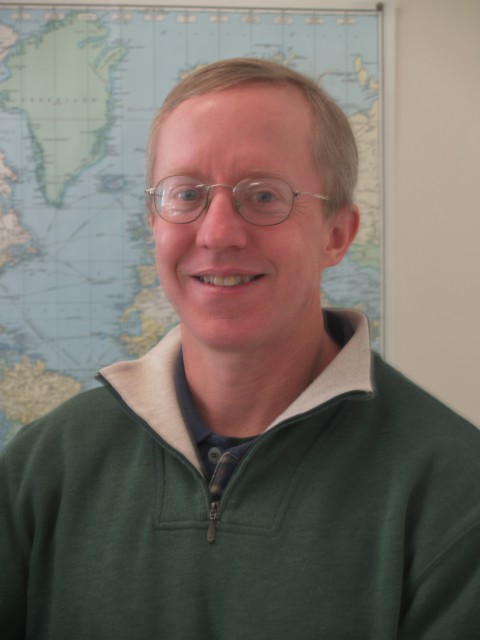
Bartolini says the chapter also took 22 members to the AMS annual meeting in Atlanta last year in February. According to Noel, almost every meteorologist in the country attends that annual conference.
“It’s a great place to network with other meteorologists,” Noel says. “You never know who is going to hire you five years from now.”
AMS exists to encourage the national spread of information among members of the meteorology field, says Doug Miller, chair of UNCA’s atmospheric sciences department and faculty adviser for its AMS chapter. The national organization, based in Boston, is made up of about 140 active chapters.
Bartolini adds that the society offers members academic opportunities, prepares them for their careers and builds community within the student body. Then there’s the hands-on, practical experience.
Fieldwork
Beyond belonging to professional organizations and the local club, students get to work in the field. Bartolini, a junior from Richmond, Va., has participated in the club since his freshman year and has worked on several research projects. One project, sponsored by researchers at Duke University, involved helping NASA calibrate a new instrument on its satellites.
“The purpose was to capture the variability of rainfall both in low and high elevations,” Bartolini says.
UNCA began installing Duke’s rain gauges in 2007, says Miller. Since then, students and professors have maintained and collected data from more than 30 gauges in the region. He says that researchers chose this area instead of one like the Rocky Mountains due to its ample rainfall (some local ranges get 90 inches a year or more).
“Our highest-elevation gauge is at Mount Guyot [in the Great Smoky Mountains National Park], and it stands at almost 6,700 feet elevation,” Miller says.
In February 2014, NASA unveiled new technology for its satellites but was unsure how well it would perform in the mountains in the middle latitudes of the U.S., Miller explains.
One aim of the project “is to try to determine how much rain is falling in each place it scans,” he says. NASA “used our observations to help calibrate the satellite instrument.”
“On any given Saturday or Sunday, two or three people … drive out there and usually service two or three rain gauges, hiking anywhere from a quarter or half a mile to 18 miles,” Bartolini says.
Boling, now a weekend meteorologist for WNCT-TV in Greenville, N.C., says hiking the Appalachian Mountains to calibrate rain gauges is one of her favorite memories of UNCA. The 2014 graduate says she enjoyed researching topics relevant to Western North Carolina, and the rain gauge project helped her to understand how terrain affects weather.
Many of the gauges are placed in locations with beautiful views but pose environmental risks, Bartolini notes. Some project participants saw bears walk by as they were collecting data, he says, and one November afternoon, severe weather struck while he and other students were nearly 8 miles away from their vehicle.
“We hiked up on a clear Saturday morning, but some clouds quickly rolled in during the early afternoon. The skies got dark pretty quickly,” Bartolini recounts. “We actually were up on top of one mountain next to a huge, metal fire lookout tower when lightning struck the tower.”
No one was hurt, and the event hasn’t stopped Bartolini from participating in ongoing projects.
Data connections
Having a national climate agency in town is a real boost for UNCA students. Dobeck, a junior, says she knows at least three students working with the Cooperative Institute for Climate and Satellites N.C. and doing climate modeling at the NCDC. And Hennon collaborated with Ken Knapp at the NCDC to develop Cyclone Center, an interactive website that allows the public to assist researchers in improving hurricane forecasting.
“There’s a big issue with the global data. There’s a lot of errors, inconsistencies,” Hennon says. Knapp’s “idea was to create this project where we could draw in people from all over the world to the website and they could answer just a few simple questions about these pictures of hurricanes.”
The Cyclone Center database contains nearly 300,000 satellite images of hurricanes since 1978, according to the website. UNCA junior Corey Lea says it guides members of the public through a process to gather critical information about the images that will help better predict future storm activity and intensity. “The hope is we can better forecast hurricanes and their paths in the future,” says Lea.
The program includes video tutorials created by Dobeck. These take volunteers through the process step by step. “I think even grade-school children can do it,” Lea says. “Anybody can look at these images and classify them.”
The public’s responses are then applied to an algorithm to determine the severity of the storm, Hennon says. Thousands of people have contributed to the research so far.
On call for severe weather
The UNCA chapter is also involved in severe-weather fieldwork. Since 2008, Christopher Godfrey, associate professor, has guided 27 students on storm chases in Kansas, Oklahoma and Texas.
“We’ll go anywhere,” Godfrey says. A two-week trip to tornado-prone regions is part of an atmospheric sciences class offered at UNCA, he says.
“I take them to Norman, Okla., to start. We visit the National Weather Center. [Students] see how people work in academia, they see how people work in the government sector, they see how people work in the private sector and they see how people work in broadcast meteorology.”
The group tours numerous Midwestern meteorology facilities on calm weather days, then chases storms when severe weather is forecast.
“They said things were looking good in Texas, so we went to Texas and caught our first tornado. That was the first storm chase of the trip,” Godfrey says, recalling one outing. “A few days later, we made it up to Kansas, and that’s where we saw our other four tornadoes.”
Lea took the trip in May 2013. Students learned how to read weather models and plan potential escape routes, he says. The next trip is planned for 2016.
Meanwhile, at home, Noel posted forecasts, updates and photos via the UNCA-AMS Twitter account (@UNCAweather) during the recent ice and snowstorms. Noel says the account, created in January, had about 100 followers before the storm, but that count has since more than doubled.
Creating a Twitter account was one facet of the AMS chapter’s effort to continue strengthening relationships with the community and professionals in the meteorology industry, Dobeck says.
Up, up and away
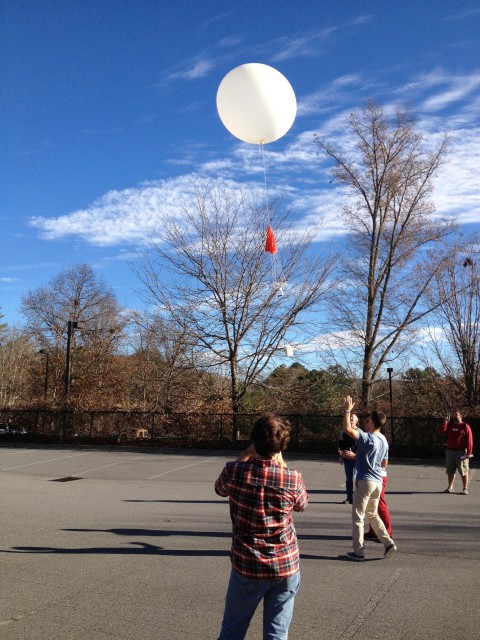
Closer to home for their fieldwork, students released five weather balloons from UNCA’s campus Feb. 25 and 26 in an effort to collect forecasting data during winter storm Remus.
“We were out all night launching weather balloons,” Miller says. “I think it was a good bunch of soundings … that is going to be good for research and also was, I think, helpful for the area forecast offices,” says Noel. The sophomore helped launch three of those balloons and says he stayed with the group at The Reuter Center on campus until dawn that Thursday.
“My job was to get the rawinsonde ready,” Noel says, referring to the lightweight, brick-sized instrument that collects data and tracks the balloon’s movement.
“About 30 minutes before the launch, we got the balloons ready,” he says. The balloons must be carefully filled with the correct amount of helium, then knotted about 10 times to ensure the gas doesn’t escape before the balloon reaches the atmosphere. This process is repeated every three hours for each release.
“There was this one moment when it was sleeting really hard, but we were just having fun,” he says.
As the balloons climb, the rawinsonde monitors wind patterns and speed, temperature, dew point and other data to construct a vertical model of the atmosphere, says Dobeck.
“We have a program on our computer that transmits the data from the rawinsonde and tells us what’s going on,” she says.
The UNCA group began launching weather balloons during winter storms in 2006, says Miller. Previous launch sites include Avery County, East Tennessee State University and Warren Wilson College.
Seen a tornado?
In the Southeast, Godfrey is leading a tornado research project aimed at eliminating inconsistencies in the enhanced Fujita system, he said. The project, funded by an internal grant last semester, will take Godfrey and students into the field immediately following tornado activity.
“With the enhanced Fujita scale, the idea is that you look at things called damage indicators,” he says. “A house could be a damage indicator. Then you look at the level of damage to that house. Did it lose its roof, or was it blown off the foundation?”
The tornado is rated on the enhanced F-scale based on estimated wind speeds from the level of damage perceived after the storm has dissipated, he said. Often, he says, the wind-speed assignment and damage are inconsistent.
“There’s a bit of a debate going on with the EF scale because it’s not very consistent,” Noel says. “There [has] been a couple of tornadoes that should have been rated EF5 because they had over 200 miles per hour winds.”
Noel, who plans to assist with this research, says one tornado in May 2013 had more than 200 mph winds and should have been ranked an EF5, but it traveled primarily across open fields in El Reno, Okla., which did not suffer much damage.
“It’s kind of hard to look at damage if there’s nothing there,” Noel says. “They didn’t find anything that supported EF5 damage, so they rated it an EF3.”
In an effort to increase the accuracy of this aspect of the enhanced F-scale, the project will focus on comparing the damage sustained by trees to the damage sustained by houses nearby, Godfrey says. Once researchers can determine that relationship, the results can be used to more accurately rate tornadoes that travel across expanses where there are no houses, he adds.
“For example, if a house is rated as an EF2 damage, then we look at the tree and see what kind of damage it had,” Godfrey says. “Did it lose its branches? Was it uprooted? Was it snapped? What kind of tree is it? How big is the tree? With all that information, we can fix some of the problems with the enhanced Fujita scale.”
The research will take place this spring or early summer, Godfrey says.
“At this point,” says Godfrey, “we’re just waiting for a tornado to happen somewhere nearby — within 500 miles — and we’ll go.”


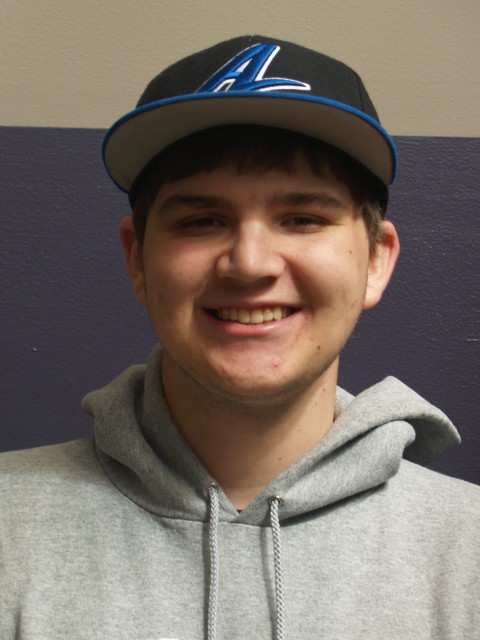

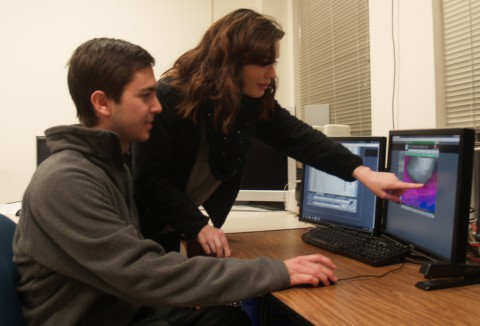
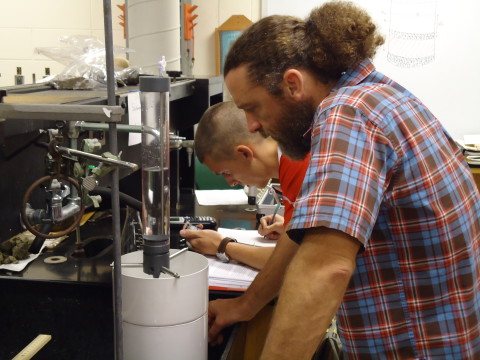

The Atmospheric Science Department at UNC Asheville is the best in the Eastern US region when it comes to studying Atmospheric Sciences whether it is Climatology, Meteorology, or Broadcast Meteorology.
Great article! Glad to see all the great things going on in ATMS at UNCA.